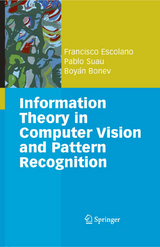Information Theory in Computer Vision and Pattern Recognition
Seiten
2009
Springer London Ltd (Verlag)
978-1-84882-296-2 (ISBN)
Springer London Ltd (Verlag)
978-1-84882-296-2 (ISBN)
Information theory has proved to be effective for solving many computer vision and pattern recognition (CVPR) problems (such as image matching, clustering and segmentation, saliency detection, feature selection, optimal classifier design and many others).
Information theory has proved to be effective for solving many computer vision and pattern recognition (CVPR) problems (such as image matching, clustering and segmentation, saliency detection, feature selection, optimal classifier design and many others). Nowadays, researchers are widely bringing information theory elements to the CVPR arena. Among these elements there are measures (entropy, mutual information…), principles (maximum entropy, minimax entropy…) and theories (rate distortion theory, method of types…).
This book explores and introduces the latter elements through an incremental complexity approach at the same time where CVPR problems are formulated and the most representative algorithms are presented. Interesting connections between information theory principles when applied to different problems are highlighted, seeking a comprehensive research roadmap. The result is a novel tool both for CVPR and machine learning researchers, and contributes to across-fertilization of both areas.
Information theory has proved to be effective for solving many computer vision and pattern recognition (CVPR) problems (such as image matching, clustering and segmentation, saliency detection, feature selection, optimal classifier design and many others). Nowadays, researchers are widely bringing information theory elements to the CVPR arena. Among these elements there are measures (entropy, mutual information…), principles (maximum entropy, minimax entropy…) and theories (rate distortion theory, method of types…).
This book explores and introduces the latter elements through an incremental complexity approach at the same time where CVPR problems are formulated and the most representative algorithms are presented. Interesting connections between information theory principles when applied to different problems are highlighted, seeking a comprehensive research roadmap. The result is a novel tool both for CVPR and machine learning researchers, and contributes to across-fertilization of both areas.
Interest Points, Edges, and Contour Grouping.- Contour and Region-Based Image Segmentation.- Registration, Matching, and Recognition.- Image and Pattern Clustering.- Feature Selection and Transformation.- Classifier Design.
| Erscheint lt. Verlag | 31.7.2009 |
|---|---|
| Vorwort | Alan L. Yuille |
| Zusatzinfo | XVII, 364 p. |
| Verlagsort | England |
| Sprache | englisch |
| Maße | 155 x 235 mm |
| Themenwelt | Informatik ► Grafik / Design ► Digitale Bildverarbeitung |
| Informatik ► Theorie / Studium ► Künstliche Intelligenz / Robotik | |
| ISBN-10 | 1-84882-296-0 / 1848822960 |
| ISBN-13 | 978-1-84882-296-2 / 9781848822962 |
| Zustand | Neuware |
| Haben Sie eine Frage zum Produkt? |
Mehr entdecken
aus dem Bereich
aus dem Bereich
alles zum Drucken, Scannen, Modellieren
Buch | Softcover (2024)
Markt + Technik Verlag
24,95 €
Methoden, Konzepte und Algorithmen in der Optotechnik, optischen …
Buch | Hardcover (2024)
Hanser (Verlag)
39,99 €




